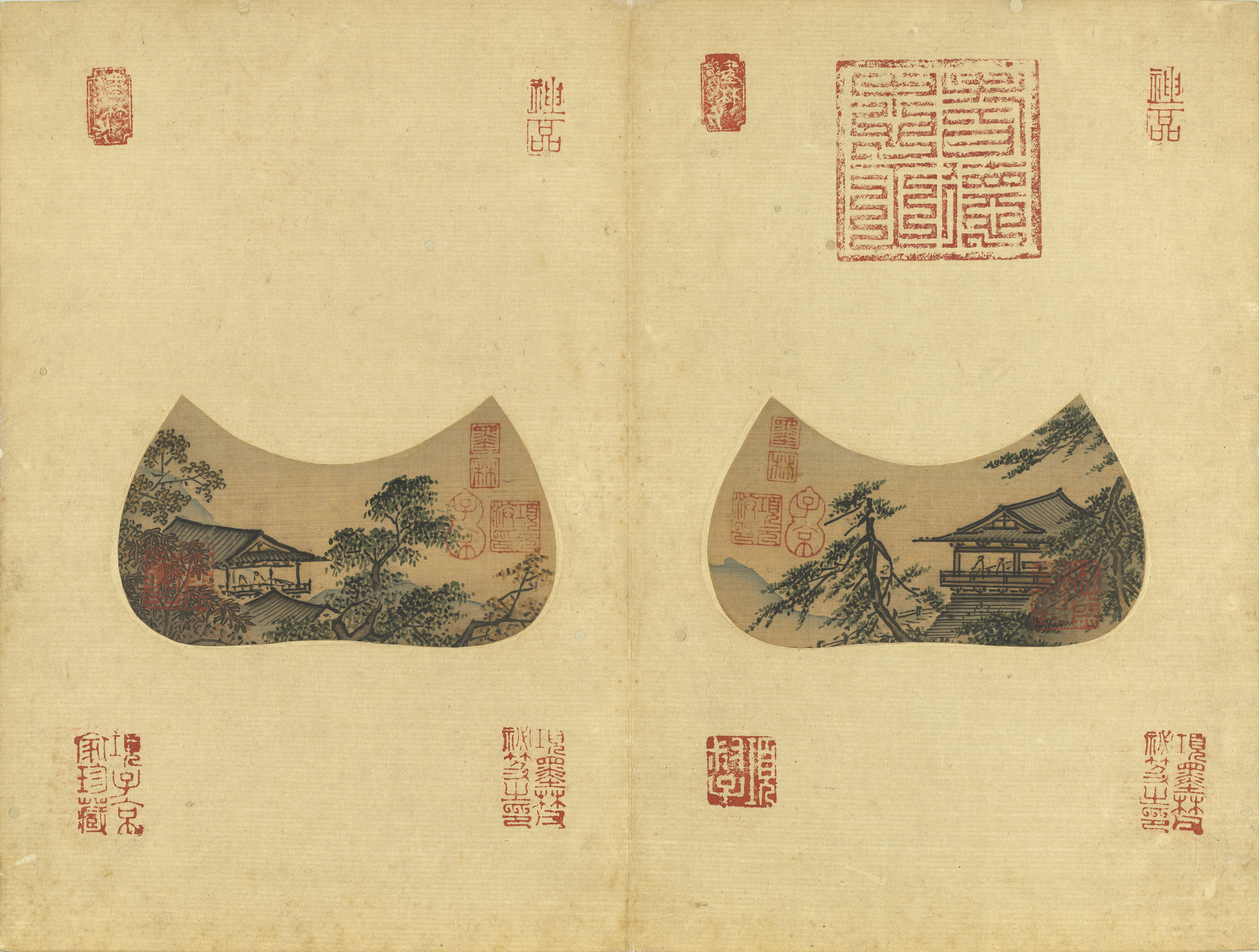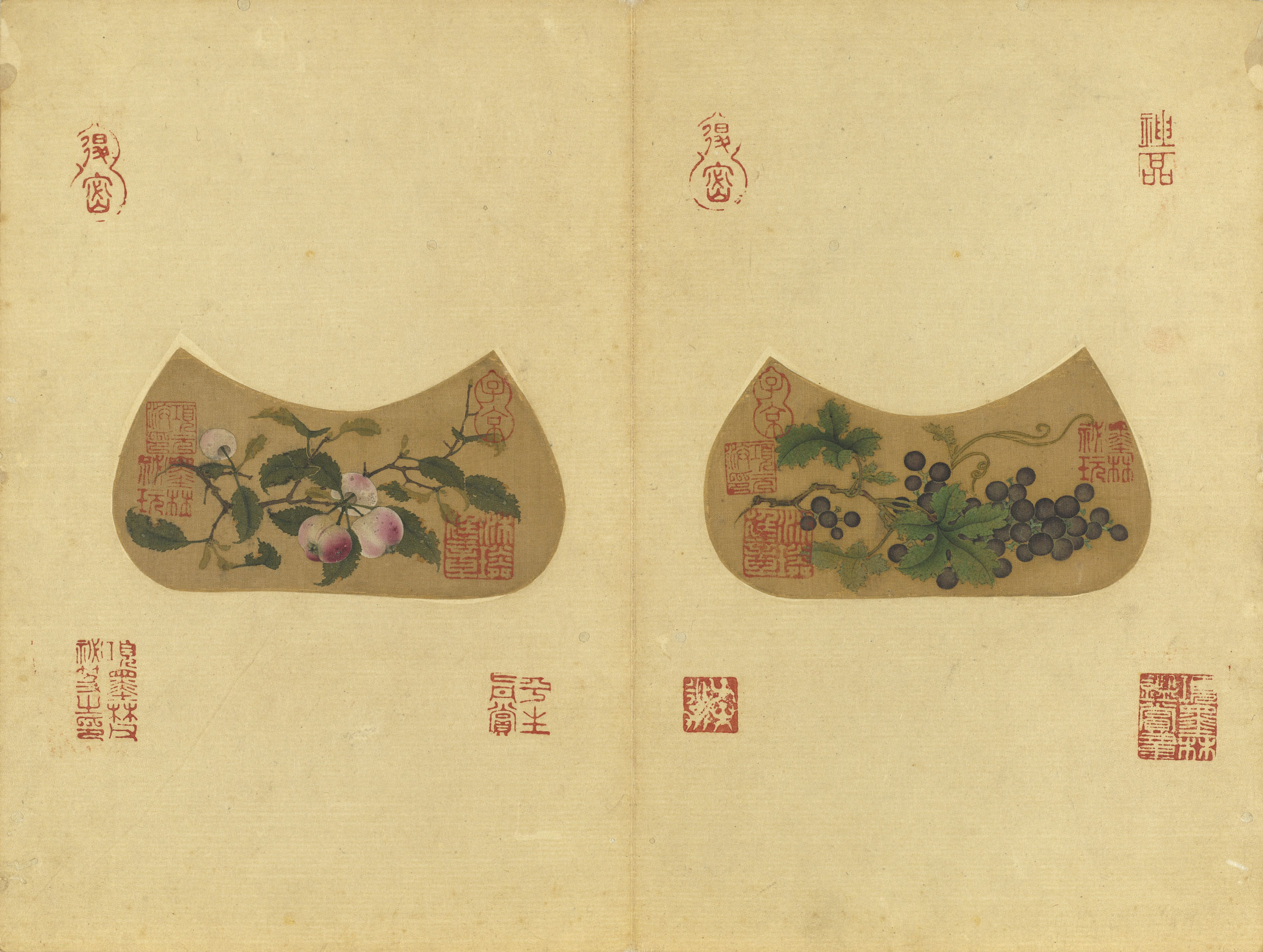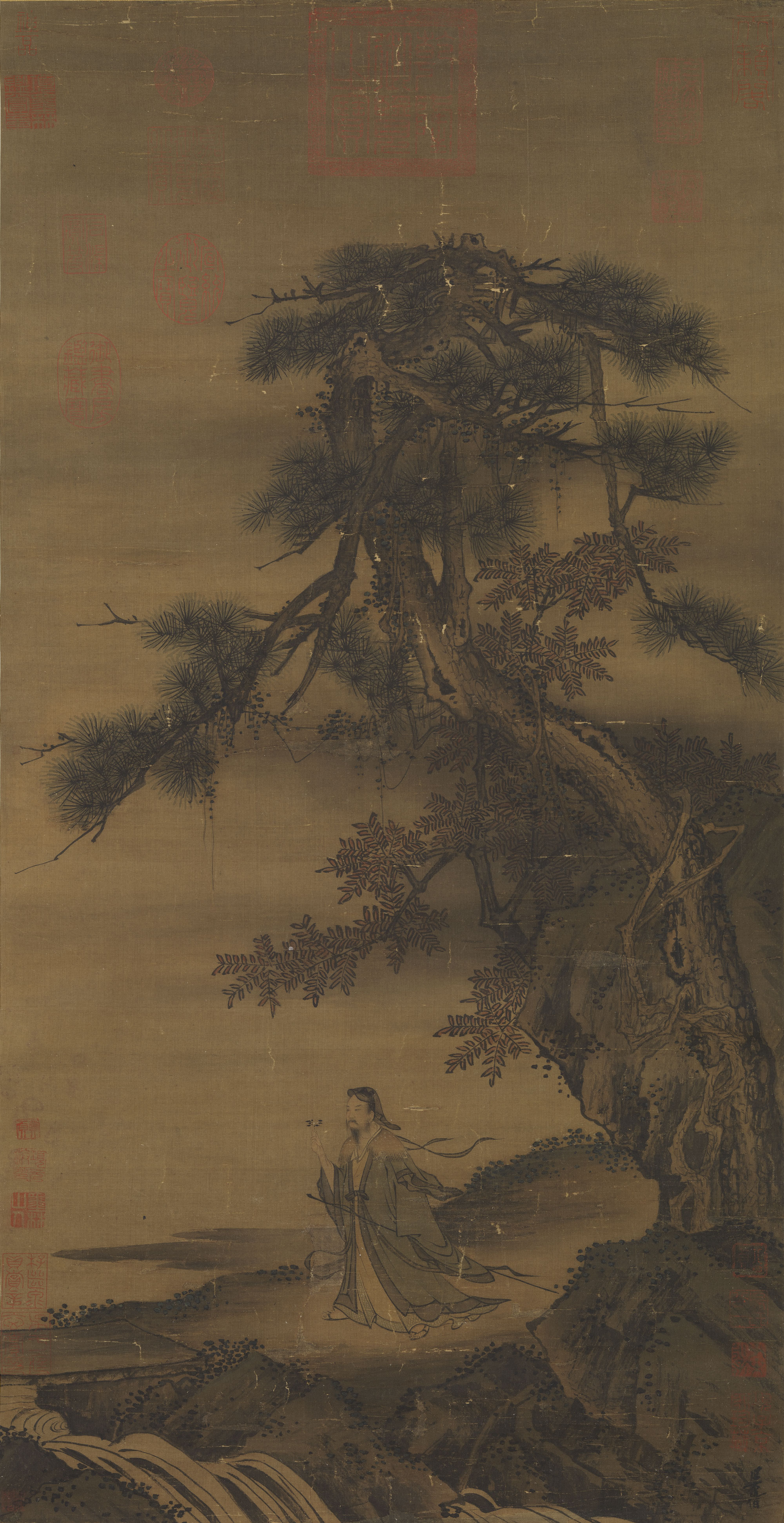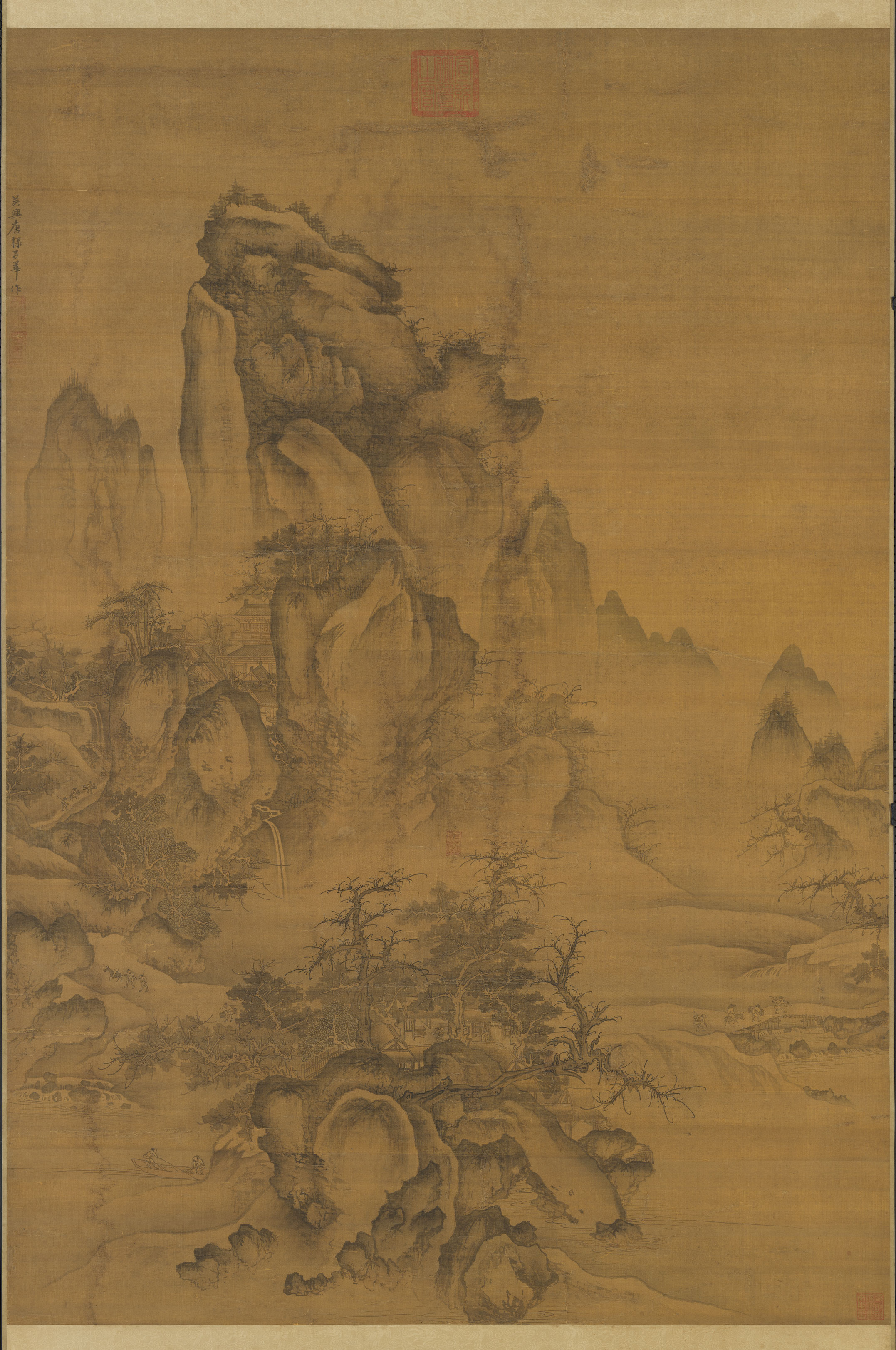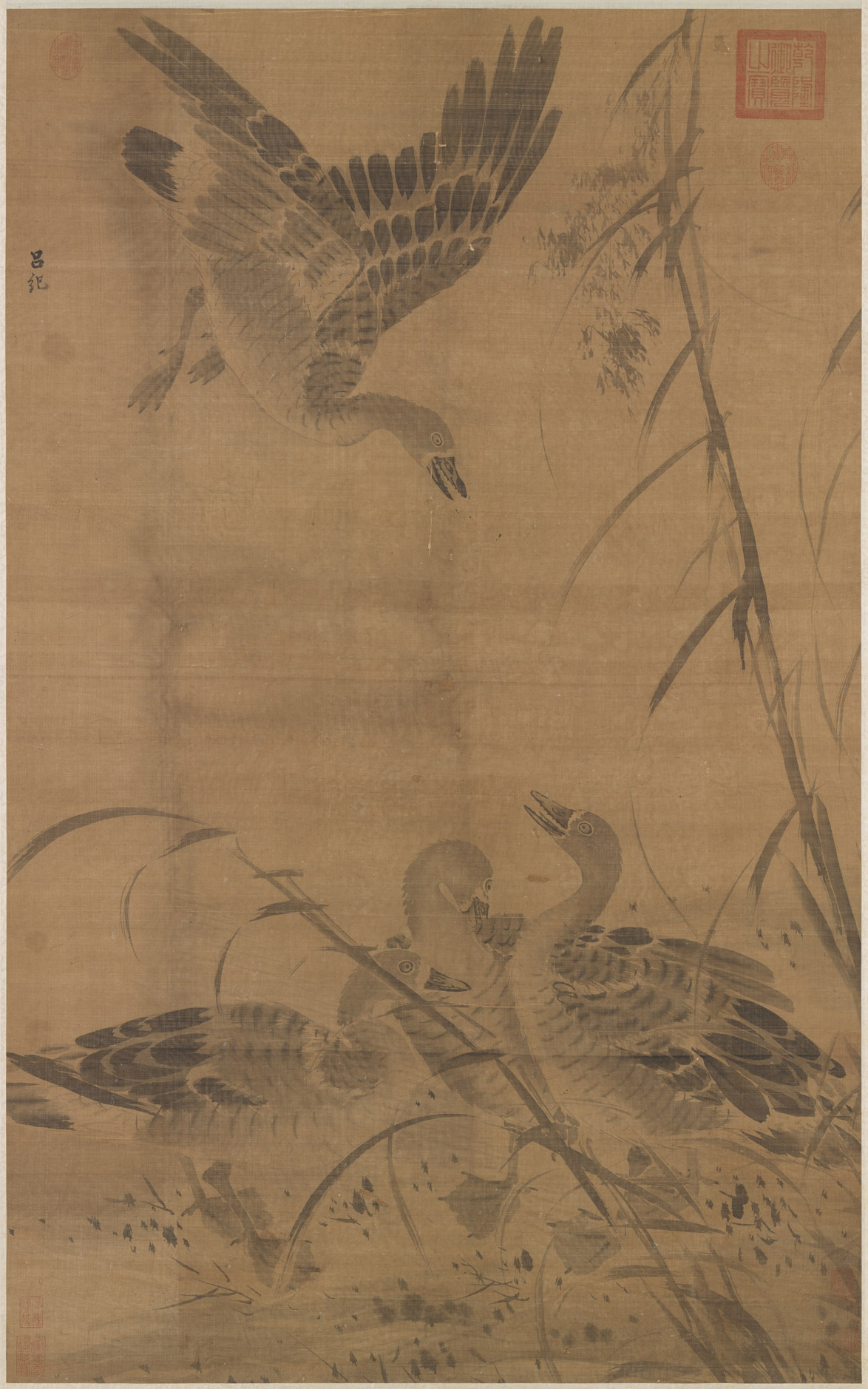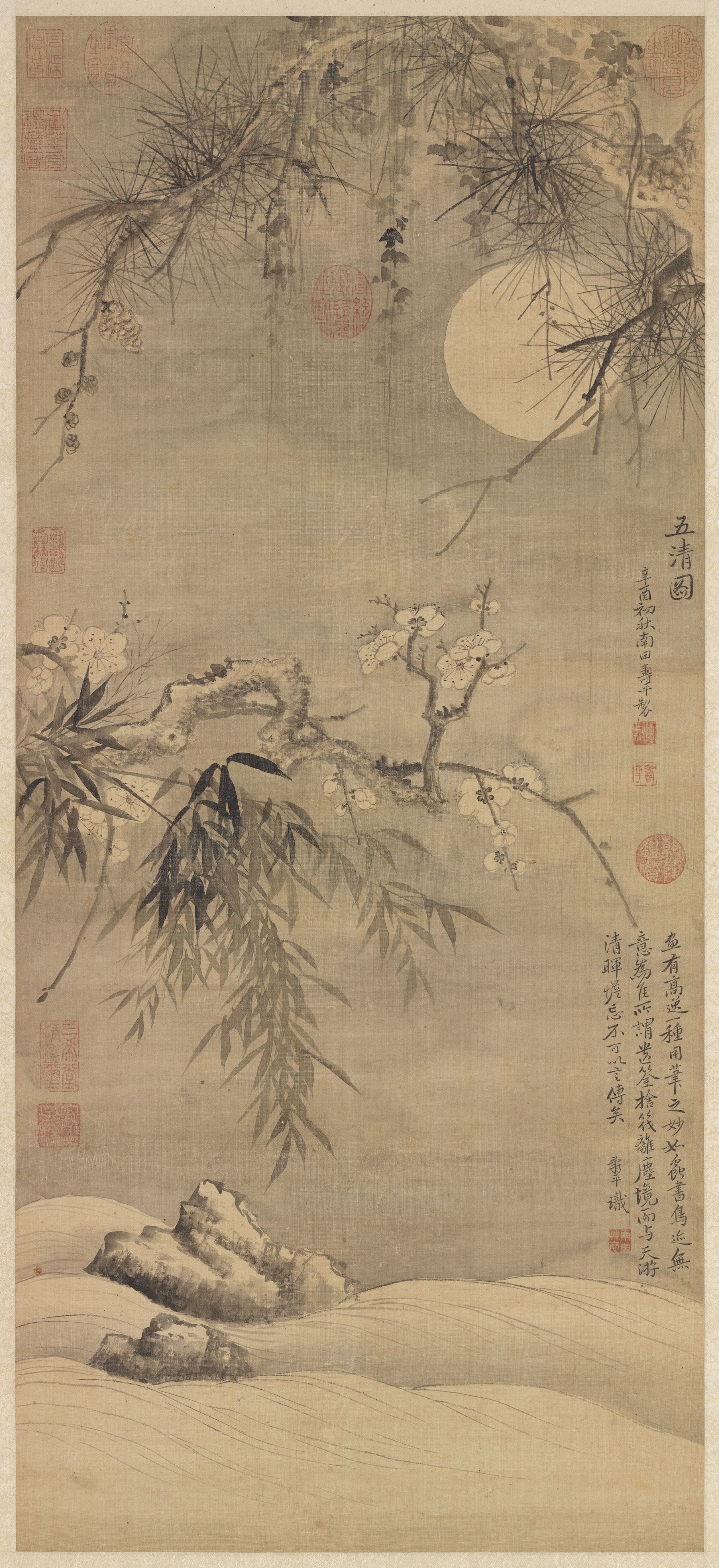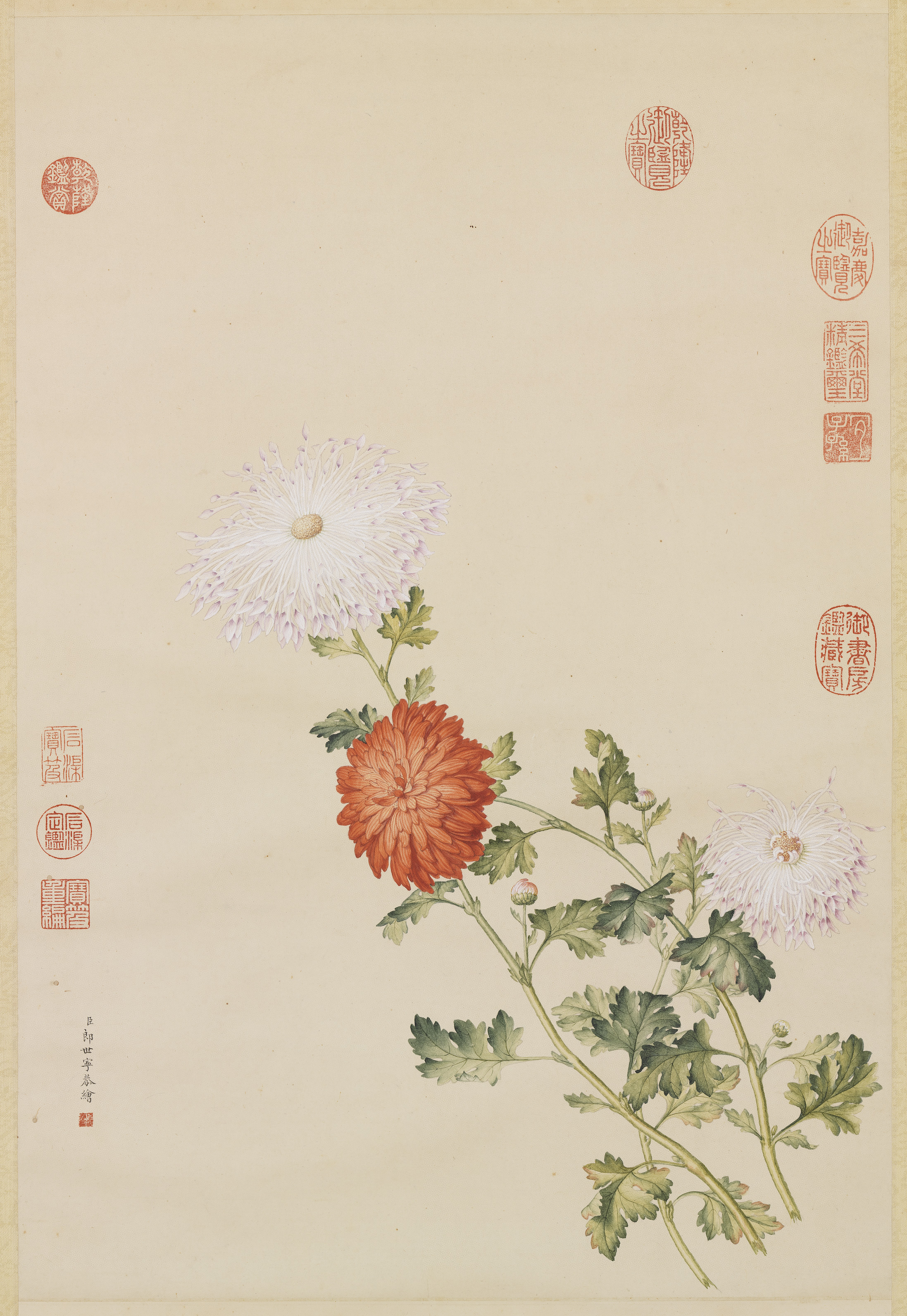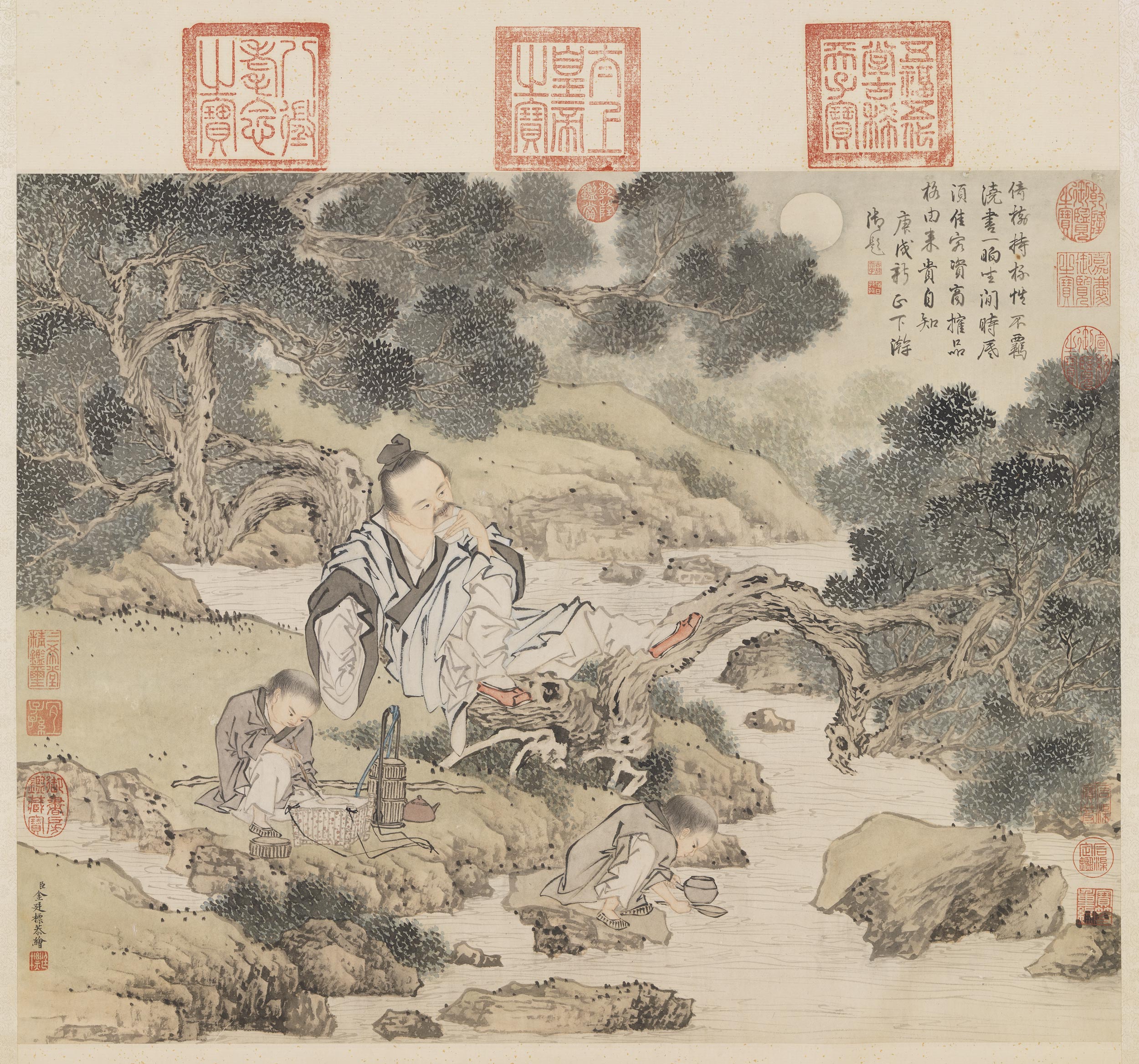Selections
-
Emperor Minghuang Playing Chess
- Attributed to Zhou Wenju (fl. 10th century CE), Southern Tang dynasty (Five Dynasties Period)
This painting depicts members of the Tang dynasty court who have gathered while the emperor plays the board game go. Tang emperor Xuanzong (685-762) is portrayed seated atop a dragon throne with a go board before him, as a mix of ministers, Buddhist monks, Daoist adepts, and attendants look on. The man shown bent slightly forwards, wearing crimson robes with a drawing of a jester on the back is likely himself a jester or performing artist. During the Qing dynasty, Emperor Qianlong (1711-1799) wrote a poem stating that Emperor Xuanzong's indulgently allowing his consort Yang Guifei (719-756) to let her dog run amok and upset the go board foreshadowed the political chaos that was soon to come. This scroll was painted with an elegant palette of muted colors. The human figures are especially lifelike and expressive, and the folds and creases in the fabric of their clothing were painted with tremendous care.
This work does not bear any attributing marks, but it was long said to be the work of Zhou Wenju (fl. 10th century CE) of the Southern Tang dynasty. However, a close examination of this painting suggests it is much closer in style to the work of the Yuan dynasty artist Ren Renfa (1255-1327). -
Intimate Scenes
- Ma Yuan (fl. 1180-1224), Song dynasty
This album boasts a selection of paintings of camellias, peonies, grapes, and peaches. Their brushwork is impeccable, to the degree that the veins on the flowers and leaves are painted to near perfection. Quite uniquely, the paintings on two of the leaves were mounted with canoe-shaped borders. The remaining leaves contain landscapes and human figures. Their scenery includes hills and pavilions, with travelers traversing the mountains, staffs in hand, or navigating rivers in boats. The images all have a refreshing character, as though unencumbered by the world.
The paintings do not bear the artist's seal, but they have been attributed to Ma Yuan (fl. 1180-1224); despite their small size, his signature style can be discerned in these works' compositions. The selections on display represent the fourth, fifth, sixth, and seventh leaves in Ma's Intimate Scenes collection. -
Gentleman of the Eastern Fence
- Liang Kai (ca. 13th century), Song Dynasty
Liang Kai (ca. 13th century) was a native of Dongping in present day Shandong province. His expertise lay in painting human figures and landscapes, and he was a court painter during the Southern Song dynasty under the reign of Emperor Ningzong.
This painting depicts a riverside replete with a dense outgrowth of lush trees, including a maple whose leaves are dappled with cinnabar ink. The artist wielded his brush at an angle to texture the timber and stones with "axe-cut strokes," while the outlines are so precise as to evoke the style of Southern Song dynasty painters. The recluse in this painting wears a Chan Buddhist monk's robes with a deerskin cape draped over his shoulders. Walking with a staff, he holds a chrysanthemum in his right hand, quite likely indicating that this is meant to be a portrait of the great Six Dynasties period poet, Tao Yuanming (ca. 365-427). Liang Kai's signature is visible at the foot of the bank in the lower right corner, but the characters differ from those on known authentic works, suggesting that this is in fact an extremely faithful, high-quality forgery. -
After Guo Xi's "Travelers in Autumn Mountains"
- Tang Di (ca. 1287-1355), Yuan dynasty
Tang Di (ca. 1287-1355), whose style name was Zihua, was a native of Wuxing in present day Zhejiang province.
This painting shows a brisk, autumnal scene where mountain mists soar into the empyrean above towering peaks and ancient hermitages nestled into the valleys. Thatched cottages stand out in the foreground, while travelers on mountain paths and bridges crossing the rivers fill the scroll with life. The painting's composition takes after the Song dynasty painter Guo Xi's "Early Spring." The ways its mountains and boulders were painted with "curled-cloud" strokes and its trees stand tall with leafless "crab claw-like" branches show strong influences from both Guo Xi and Li Cheng. Tang Di's skill came to the attention of Yuan emperor Shundi after he painted the Jiaxi Palace. He also enjoyed the favors of Yuan emperor Wenzong after painting frescos in Soaring Dragons Gathered Blessings Temple in Jinling (near present day Nanjing). -
Wild Geese Gathering on an Islet
- Lü Ji (f. 1475-1503), Ming dynasty
Lü Ji (f. 1475-1503), whose style name was Tingzhen, was a native of Yin County (present day Ningbo) in Zhejiang province.
This painting depicts two pairs of geese in the autumn, fluttering amid the reeds bordering a pond. One goose can be seen preparing to alight, as another raises its head skywards. There is a rich, dynamic tension between the two geese in motion and the two in repose. The seal bearing Lü Ji's name seems to have been a later addition to this work. There is another seal on the lower right hand portion of this work with the characters "Yishan," which comprise the painter Lin Liang's style name. Lin Liang (ca. 1428-1494) was a court painter in the Palace of Benevolence and Wisdom (Renzhi Dian) during the Hongzhi reign period (1488-1505) of Ming dynasty emperor Xiaozong. Lin served as a commander in the imperial bodyguard, a military unit that also provided sinecures for court painters. Lin and Lü Ji served consecutively at the Ming imperial court. -
Pines and Summits Encompassing the Void
- Ding Yunping (1547 or 1548-after 1629), Ming dynasty
Ding Yunping (1547 or 1548-after 1629), a native of Xiuning in Anhui province, went by the style name Nanyu and the sobriquet Recluse of the Sagely Efflorescence (Shenghua Jushi). He was one of the great masters of the late Ming dynasty.
On this scroll can be seen a narrow path winding across pine-covered bluffs, over which a scholar and a child take a leisurely stroll, singing as they go. The space above the cliffs is broken by a massive wall of cloud, beyond which an even denser forest of pines and firs can be seen, its furthest reaches revealing a Buddhist temple. The horizontally-inclined massif behind the forest is remarkably simple in its composition, but above it rises a final row of peaks whose crags are painted in a dense and elaborate manner. Ding showcased his ability to embrace simplicity in the midst of complexity in this work, evoking a unique charm that shines through the painting's density. This work, one of Ding's truly outstanding masterpieces, was painted in the forty-second year of Ming emperor Wanli's reign (1614), when the artist was sixty-eight years old. -
Seeking Antiquity at Fengjing
- Dong Qichang (1555-1636), Ming dynasty
Dong Qichang (1555-1636), whose style name was Xuanzai, was a native of Huating in Songjiang prefecture (present day Shanghai). A noted connoisseur of the arts, Dong was also an important painter, calligrapher, and theorist during the latter years of the Ming dynasty.
This painting was completed in the thirtieth year of Ming emperor Wanli's reign (1602). The inscription describes how when Dong accompanied his friend Gu Jiming on a return journey to Zuili (present day Jiaxing in Zhejiang province), the two of them encountered heavy rains that forced them to take lodging in Fengjing. While in Fenjing exploring ancient landmarks, Dong was inspired to produce this work. He used "hemp fiber" brushstrokes to paint the mountains and boulders, whose arrangement involves a delightful interplay between denseness and sparseness. The contrasts between heavy and light ink washes as well as the use of points and strokes are quite stark, while the layout of the mountains, boulders, and trees emphasizes connectedness and movement. In a colophon, Chen Jiru (1558-1639) declared that this painting allows us to see Dong's stylistic interpretation of the great painters Wang Wei and Dong Yuan. -
The Five Purities
- Yun Shouping (1633-1690), Qing dynasty
Yun Shouping (1633-1690), whose given name was Ge and whose sobriquet was Southern Field (Nantian), went by his style name, Shouping. A native of Wujin in Jiangsu province, Yun was a talented landscape painter, but his true specialty was in paintings of flowers, foliage, and insects. By making modifications to classical "boneless" painting techniques, Yun created his own unique style of painting from life, earning him recognition as the Qing dynasty's most outstanding painter of flowers and plants.
"The Five Purities" is a reference to pines, bamboo, plum blossoms, water, and the moon, which are themselves metaphors for the constancy of character and clarity of sentiment that were meant to be displayed by cultivated individuals. The usage of both brush and ink in this work demonstrate extraordinary versatility. The ink was compellingly applied in a manner that gives a sense of dryness, with heavy washes giving way to lightness. The overall effect of Yun's technique imbues the painting with a lofty, highly-refined air. The inscription on this painting dates it to the year of Xin-you, when the artist was forty-nine years old. -
Chrysanthemums of the West
- Lang Shining (Giuseppe Castiglione, 1688-1766), Qing dynasty
Giuseppe Castiglione (1688-1766), whose Chinese name was Lang Shining, was an Italian missionary painter. For a period of fifty-one years spanning Qing dynasty emperors Kangxi and Qianlong's reigns, Castiglione was employed to paint for the imperial court.
Chrysanthemums come in incredible variety, and during Emperor Qianlong's reign "overseas chrysanthemums" began to be imported into China. Beloved for the novelty of their colors and the shapes of their petals, they were planted in palace gardens in profusion. The flowers' petals in this work were outlined with exacting precision, leaving them with a profound sense of layering, while their leaves were rendered with remarkable washes in a wide range of hues. A record from the Archives of the Imperial Workshops in 1758 mentions an order to mount a hanging scroll painting of chrysanthemums done on paper by Castiglione, perhaps referring to this work. -
Tasting Tea Steeped with Spring Water
- Jin Tingbiao (?-1767), Qing dynasty
Jin Tingbiao (?-1767), whose style name was Shikui, was a native of Wucheng (present day Huzhou) in Zhejiang province. Most renowned for his paintings of human figures, Jin was also a skilled painter of scenes of flowers and foliage as well as landscapes. He excelled at the baimiao (ink outline) and jiehua (ruled line) painting techniques.
In this painting of a sylvan spring bathed in moonlight, a scholar-official sits beside a creek bubbling with spring water, sipping tea in a state of utter repose. Near him, a child squats at the bank to draw water, while another lights coal in a small stove housed in a bamboo frame. All of the accoutrements of tea-drinking—including the stove, a tea pot, a carrying basket, a jar, a spoon, and tea cups—were painted with meticulous detail. Jin employed a limpid and restrained palette for this work, which he applied with masterful use of brush and ink. The scholar's round and somewhat small face show Jin's highly unique way of painting. The robes, whose fabric ripples and folds dramatically, were painted with brushstrokes that closely resemble the "snapped reed" technique.



